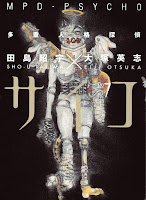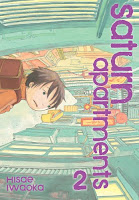Support manga, support your library!
Here’s what I’ve been reading:
 Basara, Volumes 1-5 by Yumi Tamura. After reading only the first five volumes of Basara, I am already convinced that I want to own the entire series. Unfortunately, parts of it are tragically out of print. What’s also unfortunate? My library only has the first five volumes. Basara might be difficult to find but I think it’s worth tracking down. Set in a post-apocalyptic Japan, Basara follows a young woman named Sarasa. She hides the fact that her twin brother Tatara, the “child of destiny” prophesied to save their people from tyrannical imperial rule, has died by taking his place. So far, Basara is a quickly paced series featuring complex characters (including kick-ass women) and a fair amount of violence and tragedy for good measure.
Basara, Volumes 1-5 by Yumi Tamura. After reading only the first five volumes of Basara, I am already convinced that I want to own the entire series. Unfortunately, parts of it are tragically out of print. What’s also unfortunate? My library only has the first five volumes. Basara might be difficult to find but I think it’s worth tracking down. Set in a post-apocalyptic Japan, Basara follows a young woman named Sarasa. She hides the fact that her twin brother Tatara, the “child of destiny” prophesied to save their people from tyrannical imperial rule, has died by taking his place. So far, Basara is a quickly paced series featuring complex characters (including kick-ass women) and a fair amount of violence and tragedy for good measure.
 Kaze Hikaru, Volumes 1-3 by Taeko Watanabe. I enjoy a good period manga and I’ve recently developed a particular interest in the Shinsengumi, so it was about time I gave Kaze Hikaru a try. (Plus, it has cross-dressing!) The series was Watanabe’s first foray into historical manga and she put a ton of research and reference work into the story and art. Kaze Hikaru follows Tominaga Sei, a young woman who has disguised herself as a boy in order to join the Mibu-Roshi which will later become the Shinsengumi. What she lacks in skill she makes up for in enthusiasm; for personal reasons, she is determined to become a great swordsman. Like all of the Shinsengumi manga that I’ve read, there are a lot of characters to keep track of in Kaze Hikaru. But I am enjoying Watanabe’s take on the era.
Kaze Hikaru, Volumes 1-3 by Taeko Watanabe. I enjoy a good period manga and I’ve recently developed a particular interest in the Shinsengumi, so it was about time I gave Kaze Hikaru a try. (Plus, it has cross-dressing!) The series was Watanabe’s first foray into historical manga and she put a ton of research and reference work into the story and art. Kaze Hikaru follows Tominaga Sei, a young woman who has disguised herself as a boy in order to join the Mibu-Roshi which will later become the Shinsengumi. What she lacks in skill she makes up for in enthusiasm; for personal reasons, she is determined to become a great swordsman. Like all of the Shinsengumi manga that I’ve read, there are a lot of characters to keep track of in Kaze Hikaru. But I am enjoying Watanabe’s take on the era.
 Nana, Volumes 13-15 by Ai Yazawa. I am still absolutely loving this series. (In fact, I finally caved and purchased an entire set. It’s just that good.) The characters and their relationships continue to grow and evolve as the series progresses. Some of them have even closer connections than I initially realized—the lives of the members of Trapnest and the Black Stones all intertwine and have been for quite some time now. Trust issues and jealousy show just how tenuous a relationship can be even when people are deeply in love. Since the beginning the narration of Nana has been somewhat ominous, implying some sort of impending tragic event without yet revealing what has happened. At this point, I’m starting to really worry.
Nana, Volumes 13-15 by Ai Yazawa. I am still absolutely loving this series. (In fact, I finally caved and purchased an entire set. It’s just that good.) The characters and their relationships continue to grow and evolve as the series progresses. Some of them have even closer connections than I initially realized—the lives of the members of Trapnest and the Black Stones all intertwine and have been for quite some time now. Trust issues and jealousy show just how tenuous a relationship can be even when people are deeply in love. Since the beginning the narration of Nana has been somewhat ominous, implying some sort of impending tragic event without yet revealing what has happened. At this point, I’m starting to really worry.
 Saturn Apartments, Volumes 3-6 by Hisae Iwaoka. It’s been a while since I’ve read any Saturn Apartments; I had forgotten how much I enjoy this quieter science fiction slice-of-life tale. At first the series seems to be fairly episodic, but as the manga develops an over-arching plot is established. Mitsu continues his training as a window washer of the ring system—a dangerous job, but one that he has come to love. Through his work the likable young man has made many connections and friends. At the same time, the tension between the working class of the lower levels and the upper class residents continues to increase. The sixth volume of Saturn Apartments is particularly excellent. I’m looking forward to seeing how Iwaoka brings everything to a close.
Saturn Apartments, Volumes 3-6 by Hisae Iwaoka. It’s been a while since I’ve read any Saturn Apartments; I had forgotten how much I enjoy this quieter science fiction slice-of-life tale. At first the series seems to be fairly episodic, but as the manga develops an over-arching plot is established. Mitsu continues his training as a window washer of the ring system—a dangerous job, but one that he has come to love. Through his work the likable young man has made many connections and friends. At the same time, the tension between the working class of the lower levels and the upper class residents continues to increase. The sixth volume of Saturn Apartments is particularly excellent. I’m looking forward to seeing how Iwaoka brings everything to a close.






